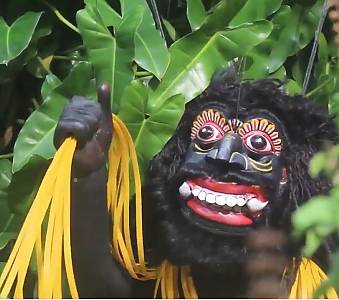1. How has Sri Lanka’s Living Heritage been affected by the Covid-19 Pandemic?
The Covid-19 pandemic has significantly affected Sri Lanka’s living heritage. Routine Buddhist rituals including the making of various offerings by devotees at prescribed times of the day at shrines are now done by the resident monks due to the lockdown. Traditional craftspeople have suspended their crafts as the collection and transportation of raw materials and selling of craft items become impossible. Two other specific examples of living culture that were affected by the Covid-19 are outlined below.
1.1 Proscription of the annual Buddhist pilgrimages to Adam’s Peak: Many Sri Lankan Buddhists make annual pilgrimages to the summit of Adam’s Peak (2,243 m above sea level) to worship what they believe to be the footprint of Buddha, and to invoke the blessings of the deity Saman, the mountain’s presiding deity and one of the four guardian deities of the island.
The pilgrimage season traditionally begins on the full-moon day of December and ends on the full-moon day of April. This is an important element of the country’s living heritage that is associated with countless beliefs, rituals, folklore, poetry, taboos, and other cultural practices. The caretaker monks were forced to end the pilgrimage season in the fourth week of March due to the lockdown and proscription of large gatherings to prevent the spread of the virus.
1.2. Restricting the celebration of the Sinhala and Tamil New Year: Buddhist Sinhalese and Hindu Tamils of Sri Lanka celebrate their traditional New Year in mid-April to mark the entering of the sun to the house of Aries from the house of Pisces according to ancient Indian astrology. Celebrations include religious observances, dressing-up with new clothes, cooking milk-rice at an auspicious moment, family and extended family reunions at ancestral homes, showing gratitude to parents, pardoning each other for past mistakes and renewing relationships, exchange of traditional sweets among the neighbors, and community entertainment with traditional games.
Celebrations end with ritual anointing events often held at temples, followed by leaving home at an auspicious time for one’s own vocation. As a measure to prevent the spread of the virus, the government requested the public to restrict the celebrations to be done within the family with no visits of the extended family and relatives, community gatherings or seeing neighbors, thus missing the most important cultural attributes of the celebrations.
2. Examples of the Use of Living Heritage to Cope with the Current Situation
2.1. Chanting of the Ratana Sutta (Discourse of the Precious Jewels) by Buddhist monks to ward-off the pandemic: Chanting of selected discourses of the Buddha known as suttas (sutra in Sanskrit), by monks to protect people from natural calamities has been a deeply-rooted cultural practice in Sri Lanka since the ancient times.
Accordingly, Buddhist monks at numerous monasteries chanted the Ratana Sutta for several days. The major chanting event began on 18th March at the Temple of the Sacred Tooth Relic in the World Heritage City of Kandy that was continued for seven days and nights, with the sanctified water being sprinkled over the country from the helicopter.
2.2 Traditional String Puppet Drama to Advise the Public on how to Respond to the Pandemic: One practitioner of traditional string puppet drama has produced four short video clips to educate the public on responsible behavior to prevent the spread of the virus. He uses the traditional puppet drama characters and characters from contemporary life to convey the message. Although string puppet dramas are traditionally performed inside darkened spaces using purpose-built stages, these episodes take place outdoors in daylight, creating a sense of realism that makes it easy to convey the message across to the viewer.
- Relevant links:
Chanting of the Ratana Sutta:
https://www.youtube.com/watch?v=ns__9L-AXz0
https://www.youtube.com/watch?v=NHQLDvmhWpY
Four string puppet video clips:
https://www.youtube.com/watch?v=RpICM3fHuMY
https://www.youtube.com/watch?v=5JgE7S84Ci8 https://www.facebook.com/production.naviya99/videos/221879112493514/ https://www.facebook.com/production.naviya99/videos/216006639640241/
The designations employed and the presentation in the texts and documents referenced in this platform do not imply the expression of any opinion whatsoever on the part of UNESCO concerning the legal status of any country, territory, city or area or of its authorities or concerning the delimitation of its frontiers or boundaries.
